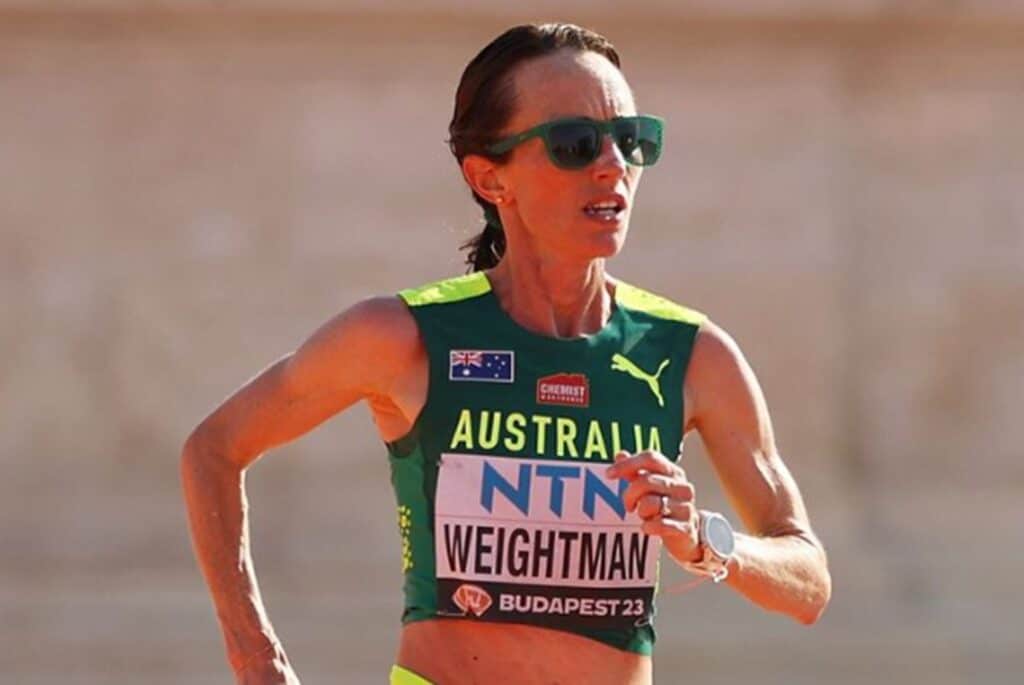Four-time Olympian Lisa Weightman has been passed over by Athletics Australia (AA) for a historic fifth marathon at the Games, despite qualifying.
The national committee holds the final say on which athletes will represent the country at the upcoming 2024 Paris Olympics, however, they’ve now been accused of breaking their own selection criteria for the women’s marathon selections.
With three female athletes allowed on the national Olympic marathon team, the 45-year-old Australian Lisa Weightman wasn’t among the three chosen despite running the third fastest time for Australian women– 2:23:15.
Weightman, 45, initially lodged an appeal against the National Sports Tribunal (NST), in May, to contest the decision, with the NST recommending that AA appoint an independent committee to reconsider their selection.
AA declined to do this after providing documentation as to why Weightman hadn’t been chosen.
Six Australian women met the entry standard of 2:26:50 within the qualification period, and the three athletes chosen by AAA’s final decision are Sinead Diver, Genevieve Gregson and Jess Stenson. Within the qualification period, Diver ran 2:21:34, Gregson ran 2:23:08 and Stenson ran 2:24:01.
Izzi Batt-Doyle and Eloise Wellings were the remaining two who beat the Olympic qualifying standard, in times of 2:23:27 and 2:25:47, respectively.
On Wednesday, Weightman informed AA– five minutes before the 5:10pm deadline– that she was going to make one final appeal to the Court of Arbitration for Sport in Switzerland (CAS). However, several hours later, she decided against this, citing financial concerns against the likelihood that the AA decision would be overturned in her favour.
Weightman’s manager, Robert Joske told Nine that the Weightman camp had spent thousands of dollars in engaging the NST. It’s estimated that getting the CAS involved would be a $50,000 legal bill, which prompted Weightman to reluctantly turn down her final opportunity to appeal.
With four Olympics already behind her, being chosen for Paris would have been historic for Weightman as the first Australian track and field athlete to compete at five Olympics.
The Olympic women’s marathon is scheduled to take place August 11, 2024, one day after the men’s race.
How do other countries select athletes to send to the Olympic marathon?
Globally, each country can send a maximum of three women and three men to the Olympic Marathon, but no country is guaranteed three spots.
Runners must meet the qualification requirements set by World Athletics. These include running a fast enough qualifying time (2:08:10 for men, 2:26:50 for women). Place in the top five at a World Athletics platinum-level race and reach a ranking high enough in the World Athletics ranking system.
Then, once athletes have ‘unlocked’ spots for their country, each country’s federation can then select any three-qualified athletes it wants to send to the Olympic Games.
Many countries’ federations, such as Australia, do this by a committee decision– as is the controversy with the decision not to send Weightman to Paris.
Other countries, like the US for example, have opted to use a trials race to remove accusations of favouritism.
The aftermath of AA’s decision for Olympic female athletes
Amid AA’s controversial decision not to send Weightman to Paris, the female athlete chosen in her place– Jess Stenson– has been receiving criticism. And this raises the question of why two impressive female athletes must be pitted against each other by some in the media due to a decision made by a national organisation.
At the Commonwealth Games marathon in 2022, Stenson won the race in a personal best time of 2:24:01, just six months after the birth of her second child. Along with this impressive return to elite marathoning, she has also twice finished in the top 12 in world championships marathons and was 22nd at the Rio Olympics.
On Tuesday, it’s been reported that Weigtman’s husband, Lachlan McArthur, tweeted at Stenson asking her to remove the header image on her Twitter account which pictured both families after a race.
“@JessTrengove could you please take down your background photo of my family,” McArthur wrote, according to Fox Sports, noting the tweets have since been deleted.
“BTW, this was after one of the 7-1 all-time head to head wins by @LisaWeightman.”
Stenson changed the photo with McArthur then replying: “Thank you @JessTrengove for taking down the photo. It is much appreciated. We have a heartbroken family here”.
McArthur has since deleted his account.
Australian Olympic champion Sally Pearson has also commented on the controversial matter, voicing her heartbreak for Weightman.
“The desperately sad truth is that AA is stopping Weightman from becoming the first Aussie track and field athlete to compete at five Olympics, having debuted in the 2008 Beijing Games,” Pearson said.
“The fact that Weightman and I were flatmates inside an Olympics village previously has nothing to do with it. This is about the integrity of my sport.”
In Weightman’s own statement on the situation, she voices her disappointment saying: “I am of course disappointed by the decision given that I fought hard and fair to gain my qualification time — the third fastest of all Australian women during the qualification period.”
“However, what I am most disappointed about is AA’s own internal systems and procedures that have allowed this outcome and which, unless corrected, will negatively impact future Australian athletes and their legitimate claims to represent Australia.”
Ageism and whether older female runners are more resilient
On AA’s own website, Weightman is described as “running better than ever”, having set two marathon PBs within six months in late 2022 and early 2023 at the age of 44.
In the running world, conversation abounds surrounding whether or not female distance runners increase their performance potential with age. But unfortunately there’s not been enough research into female athleticism, despite emerging evidence.
Nevertheless, plenty of big-name women marathoners– think older marathon powerhouse names like Sarah Hall, Keira D’Amato and Stephanie Bruce– have proven that age is not always a barrier when it comes to athletic performance. In many cases, it can be a benefit.
A 2019 study conducted by Emma Lee, Eric Snyder and C.J. Lundstrom of the University of Minnesota, concluded that years of running, experience and consistent training factored into performance results. This means that in older runners, the muscles and body have been hardened to years of work, and the body is familiar with the output required to achieve a certain result.
According to data released by the running app Strava, middle-aged runners consistently average faster marathon times than younger runners in their twenties.
Another 2019 study analysed age and gender in ultra-marathon races to conclude that women reduced the performance difference to men with advancing age.
And yet, along with other areas of women’s health, there’s a lack of sport science and sport medicine research conducted on elite female athletes, with researchers saying “we are likely failing to maximise the performance potential of female athletes”.


